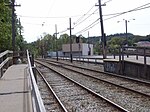Enoch Wright House
1815 establishments in PennsylvaniaFederal architecture in PennsylvaniaHouses completed in 1815Houses in Washington County, PennsylvaniaHouses on the National Register of Historic Places in Pennsylvania ... and 1 more
National Register of Historic Places in Washington County, Pennsylvania

Enoch Wright House is a historic building in Peters Township, Washington County, Pennsylvania, United States. The house was built sometime around 1815 by Enoch Wright on land he inherited from his father, Joshua, who moved to the area in around 1772. Wright family members lived in the house until 1862, when they began to rent it out. In 1972, they donated the house to the Peters Creek Historical Society, which now uses it as a museum.Bricks for the house were manufactured on site. The house was built for two families, with separate kitchens on each end. The house's 12 rooms each have their own fireplaces.
Excerpt from the Wikipedia article Enoch Wright House (License: CC BY-SA 3.0, Authors, Images).Enoch Wright House
Venetia Road, Peters Township
Geographical coordinates (GPS) Address Nearby Places Show on map
Geographical coordinates (GPS)
| Latitude | Longitude |
|---|---|
| N 40.249722222222 ° | E -80.028888888889 ° |
Address
Venetia Road
Venetia Road
15332 Peters Township
Pennsylvania, United States
Open on Google Maps









